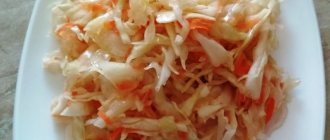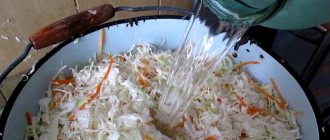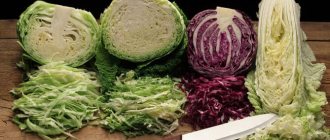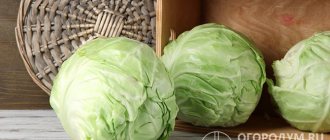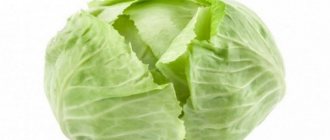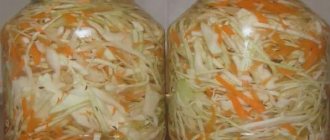Autumn-winter is the most favorable season for sauerkraut. By this time, the vegetable is ripe and completely ready for further use. For pickling, you need to prepare cabbage and other vegetables, spices, a sharp knife, a shredder, pressure and, of course, containers. Is it possible to ferment cabbage in a plastic bucket? This is exactly what the article will discuss.
What to ferment cabbage in?
You cannot find a more suitable container than a wooden barrel. But it is difficult to store it in an apartment, and it will turn out to be too much cabbage. Another problem is that it is difficult to buy a container of the required volume and made of good wood.
A large enamel pan is suitable for fermentation. Make sure it is free of chips. Otherwise, you risk spoiling the cabbage: it may acquire an unattractive gray color and an unpleasant taste.
If you need a small amount of sauerkraut, then glass containers are suitable for this: a three-liter jar or a five-liter bottle.
Under no circumstances should you take containers made of metal, such as aluminum or stainless steel. Typically, during fermentation, the acid reacts with the metal. Cabbage absorbs everything and loses its taste and usefulness. Many people wonder: is it possible to ferment cabbage in a plastic bucket?
Plastic buckets designed for cold food products are now being produced. Some sell fermented milk products, mayonnaise, salted fish, etc. But is it possible to ferment cabbage in a plastic bucket, because during fermentation, acid appears, which, one way or another, reacts with the plastic? Sauerkraut absorbs smell and unknown elements. And buckets are not always made of the right plastic. Other impurities may also be included in the composition. So, by using low-quality containers, we risk not only ruining the taste of the dish, but also our health.
But what to do if there is no other suitable container? Is it possible to ferment cabbage in a plastic bucket? Yes, you can, but you just need to listen to the following recommendations:
- Be sure to buy a plastic bucket for food grade use only. Feel free to ask the seller for a certificate to ensure the quality of your purchase.
- Buy buckets that are not made of colored plastic. It is best to take a colorless one, like a nylon lid for a jar, or a white one, like the one they sell sour cream in stores.
- Wash the new bucket several times. Then fill up with water and leave for a day. Then dry it in the open air.
- You can ferment cabbage in a plastic bucket by placing a plastic bag in it. Use only a food grade bag. Cling film used to cover the inside of the bucket is also suitable.
- You need to ferment the cabbage in a plastic bucket until fully cooked. Then it is better to transfer it into glass jars. Tamp the cabbage and pour in the resulting juice.
Sauerkraut in a barrel: recipe and preparation process
Ingredients for a 30 liter container:
- Capacity 30 l + film;
- White cabbage 25-26 kg;
- Carrots 2-2.5 kg (up to 3 kg);
- Salt at the rate of 150 g-250 g per 10 kg;
- Dill (dry “umbrellas” or seeds) 50 g (can be replaced with caraway seeds or added in equal parts);
- Black peppercorns 50-70 g;
- Bay leaf 15-20 pcs. (we determine visually according to taste).
Why no brine? Sauerkraut without brine goes through all stages of fermentation; it is a perfectly balanced natural product, almost a probiotic due to enzymes. And it's delicious.
Brine is a method of salting, pickling, but not a fermentation process. It is worth adding brine if the cabbage is not juicy, in small volumes for quick cooking.
1. Shred the cabbage.
2. Chop the carrots.
3. Wash the barrel, scald it, dry it, insert a plastic bag and secure it around the edges.
4. In a wide container, mix cabbage, carrots, and spices. Add salt little by little and mash with your hands or a pestle until the cuttings release abundant juice. There should be a lot of juice - it should cover the cabbage completely when compacted.
5. Line the bottom of the container with cabbage leaves and shredded cabbage on top. Knead so that the juice covers completely and another couple of centimeters.
Do you know when is the best time to make sauerkraut? On the days of the new moon!
7. Place the oppression: cover the surface with gauze or cotton cloth, place a wooden circle, and place the oppression on top. There is no wooden circle - any other suitable one.
8. Keep for the first 2-3 days at temperatures up to +18 °C, then move to a cool place. The readiness of cabbage depends on the volume: less fermentation at higher temperatures, and it is ready in 4-7 days.
For large volumes, from 25 to 100 liters, readiness is expected from a week to two or three, withstanding lower temperatures - from +5...+7 °C: with rapid ripening, spoilage of the product is possible.
Sometimes they cannot withstand the “warm” period at all, and the next day the workpiece is sent to a cold cellar.
Important: when storing in a cellar, do not place barrels and other containers on the floor - on a wooden floor, planks 10-15 cm high.
For what? When cooling, the ripening process slows down and can stop in a cold cellar.
And what to do with it next is another story.
Every few days it is important to check the cabbage, prick it in the center, at the edges - long, efficiently, to the very bottom.
Choosing cabbage for pickling
How to ferment cabbage in a plastic bucket? First you need to choose the right vegetables. Mid-late and late varieties of cabbage are the most suitable for harvesting for the winter. They contain sugar, which is necessary for the fermentation process. Experienced housewives recommend taking those heads of cabbage that have been caught by a slight frost, and they have been lying around for a while. Then the cabbage loses its bitterness. But avoid frozen vegetables.
For pickling, you need to choose intact and tight heads of cabbage. Leaves must be free of rot and wormholes. It is recommended to take large heads of cabbage. The result is more shredded leaves and less waste.
The benefits of sauerkraut
Sauerkraut is obtained as a result of fermentation. To prepare it, you need to chop the head of cabbage and grate the carrots. Many recipes suggest using peppers, apples, beets or cranberries.
After cutting, mix the vegetables with salt, add sugar, allspice, bay leaf and other spices to taste.
Sauerkraut contains vitamin C, known for its antioxidant properties. The absence of heat treatment allows you to completely preserve this useful element in vegetables, as well as vitamins K, group B, potassium, calcium, iron, phosphorus, zinc.
After fermentation, cabbage produces acetic and lactic acid. The calorie content of the snack is 27 kcal per 0.1 kg. Therefore, it is included in the diet menu.
Advice! Sauerkraut is recommended to people to improve digestion, especially with low stomach acidity.
You can eat cabbage if you have ulcers and liver diseases. And its brine is an anti-cold remedy.
Hypertensive patients should be careful when including pickled vegetables in their diet due to their high salt content. Then recipes are selected that require a minimum amount of it.
What can you add to sauerkraut?
Fermentation is impossible without salt. It’s best to take regular table food, and even coarsely ground. If you are starting fermentation for the first time, then you should adhere to the proportions indicated in the recipe. Experienced housewives salt by eye and to taste, which suits the needs of the family.
Bay leaves, black peppercorns, sweet and hot peppers, horseradish, apples, cranberries, pumpkin, lingonberries, plums, currant leaves and even oak bark are added to sauerkraut. And of course, there should be carrots, cut into thin slices or shredded on a coarse grater. It gives cabbage its flavor and crunchy properties.
To change the color, some housewives add sliced beets to the cabbage or add its juice. All vegetables or fruits in sauerkraut must be cut into strips.
Preparation of raw materials for salting
When planning to ferment cabbage, you first need to choose it correctly. Late and mid-late varieties are suitable for pickling. The heads of cabbage should be tight, without rot or damage. It is preferable to choose larger cabbage forks to reduce waste. The upper leaves of the head of cabbage are removed, and if necessary, any damage to it is cut out. Then you need to wash the cabbage forks and then cut them into two halves. Cut each of them in half again and remove the stalk. After this, each part is chopped or cut into pieces, depending on how you decide to ferment the cabbage.
The ingredient required for sourdough is salt. Regular food grade food is also suitable, only coarsely ground and not iodized. To improve the taste, give the finished product an attractive hue, and make the cabbage crispier, a variety of additives are used. The most common is carrots; they are chopped or cut into slices. But other additives are also popular:
- cranberries, lingonberries - make cabbage tastier and give it a decorative appearance;
- dill seeds, bay leaves, pepper, other spices - used for flavoring;
- horseradish, oak bark - to obtain crispier cabbage and increase its shelf life;
- beets – colors the vegetable a pleasant pinkish color;
- sour apples – give the dish a delicate fruity aroma.
Advice. When salting cabbage for the first time, it is advisable to strictly adhere to the chosen recipe. It’s better to experiment after gaining sufficient experience in fermenting this vegetable.
How and where to cut a cabbage head
A wide and long chef's knife is suitable for cutting cabbage; it must be well sharpened. Sometimes they use a special cut for cabbage, but it cuts the leaves too finely and they are not very suitable for pickling.
You can find a shredder board, just remember that its knives are very sharp and can easily get hurt. Therefore, you need to learn how to use it and be extremely careful.
It is best to cut cabbage on a wide table or large wooden cutting board. The chopped leaves can be left here or poured into an enamel bowl, where we will mix all the ingredients.
There are several ways to cut cabbage. In most cases, the head of cabbage is cut in half and then chopped not too finely. You can also cut the cabbage into squares. There are ways to ferment quarters, halves and even whole heads of cabbage.
Shredded cabbage is combined with salt, spices, carrots and other selected ingredients. Mix thoroughly with your hands and leave for some time until the first juice appears.
Terms and conditions of storage
You can store cabbage pickled in a bucket in the cellar, on the balcony, loggia, or even in the refrigerator if you first put it in three-liter jars. It is only necessary that the storage temperature be in the range from 0° to +5°C.
There are also more exotic ways to store pickled cabbage: it can be frozen and rolled into jars after preliminary sterilization. But the taste and consistency of the resulting product will, of course, be different, not so juicy and crispy.
Technology for laying and storing sauerkraut
Is it possible to ferment cabbage in a plastic bucket? Yes, sure. You just need to adhere to a certain technology. We begin to place the prepared vegetable mixture into the container. The bottom of the container should be lined with washed cabbage leaves. Next, add the cabbage and compact it tightly. As a rule, a wooden rolling pin is used. But you can do it with your hand. We tamp each layer of the mixture until liquid appears on the surface. Cover the top with a cabbage leaf and white natural fabric (you can use a piece of gauze). They also use a wooden circle, plate or lid, which is smaller than the diameter of the container neck, but does not leave a large distance from the walls. Be sure to put oppression on top. A stone, weight (wrapped in cling film) or a container of water is suitable for this.
We leave the container with cabbage for three to four days in a room where the temperature is not less than 17 and not more than 22 degrees. At this temperature, cabbage fermentation occurs during this time. As a result of this process, a lot of juice will be released, so place the container in another container into which the liquid will drain.
Gas bubbles and foam on the surface are considered to be indicators of proper fermentation. The foam needs to be collected from time to time. In order for the cabbage to sour evenly and for gas to escape, it must be pierced with a long wooden stick. This way you will get rid of the bitter taste of sauerkraut.
The cessation of the release of liquid and gas indicates the completion of fermentation. It's worth tasting the product. Cabbage should have a pleasant sour taste, slightly orange color and a specific aroma.
The container with sauerkraut is placed in a cooler place and stored at a temperature of 0 to 5 degrees. Some housewives practice freezing sauerkraut. The finished product is placed in freezer bags and placed in the freezer. To use, just defrost the cabbage. It is worth noting that neither taste, aroma, nor beneficial properties are lost.
Secrets of delicious cabbage
To make the cabbage crispy, use the following tricks:
- after adding salt, there is no need to knead the chopped vegetables, just carefully mix all the ingredients;
- cabbage is cut into medium-sized pieces;
- To prevent vegetables from becoming soft, add horseradish root or oak bark, which contain tannins;
- First, the cabbage is fermented at room temperature, then the container is moved to a room where the temperature is 0°C;
- when placing vegetables in a container, you need to compact them well, then place a load on top;
- It is not recommended to refreeze vegetables before use.
The following steps will help improve the taste of pickled vegetables:
- during the fermentation process, you need to remove the foam;
- regularly pierce the vegetables with a wooden stick (for uniform fermentation and release of gases);
- add cucumber pickle or sour fruit juice.
The shelf life of products can be extended if a number of conditions are met:
- jars or other containers are left in a cool place at a temperature of +1°C;
- Using a cloth soaked in alcohol to cover the cabbage will help avoid mold.
Sauerkraut in a plastic bucket: recipe
To get 10 kilograms of shredded cabbage, you need to take 12 kilograms of whole cabbage.
We separate the top leaves from the head of cabbage, divide them in half and cut out the stalk. Shred the cabbage and mix with chopped carrots (300-400 grams), salt (no more than 250 grams), add bay leaf, as well as other vegetables or fruits.
Place cabbage leaves at the bottom of the bucket. Pour the mixture on top and tamp so that liquid appears above the layer. Cover the top of the cabbage with leaves, cover with gauze and place a weight.
The fermentation process will last from 3 to 5 days. Don’t forget to collect the foam and pierce the cabbage with a stick to the very bottom. Every day you need to wash the gauze and wash the load. Store ready-made sauerkraut in a cool place.
Cucumbers in a plastic barrel
It is advisable to choose pickling cucumbers.
You can recognize them by their bumpy surface and black spines. We carefully inspect the fruits and sort them by “composition”: ideally, they should all be of medium size so that they are evenly saturated with brine and spices. Then wash the cucumbers thoroughly and soak in cool water for 2-3 hours. To preserve their bright color and crisp crunch, you can scald them with boiling water and immediately rinse them with cold water. This technique also helps speed up the onset of fermentation.
Traditional recipe
To prepare pickles “classically” we take the following ingredients:
- 20 kg
of fresh cucumbers; - 10 liters
of water; - 800 g
salt; - 3
medium sized heads of garlic; - 600 g
dill stems and umbrellas; - 150 g
leaves and
2
large horseradish roots; - 100 g
each of currant and cherry leaves.
While the cucumbers lie in the water and get rid of bitterness, prepare the spices. Peel the horseradish root and cut it into small pieces. Peel the garlic. Chop the dill stems into small pieces.
Bring the water to a boil, add salt and remove the pan from the stove. After cooling, strain through a sieve. We rub the walls of the barrel with garlic, and put some of the spices and herbs on the bottom. Place the bottom layer of cucumbers – vertically and as tightly as possible. For convenience, the barrel can be tilted. A layer of greens, another layer of cucumbers - and so on until the barrel is full.
Fill everything with brine, cover with a wooden disk or ceramic plate, on which we place pressure. We keep the barrel warm for 2-3 days for fermentation to begin, then move it to a cool place.
Cold salting method
So called because the water does not need to be boiled. The composition is also slightly different:
- 20 kg
of fresh cucumbers; - 10 liters
of water; - 1200 g
salt; - 2
large heads of garlic; - 1500 g
dill stems and umbrellas; - 200 g
leaves and 3 large horseradish roots; - 200 g
currant leaves.
Soak cucumbers in water. Wash the greens, clean and chop the horseradish root. Peel the garlic, crush it and rub it on the inside of the barrel wall. Place a third of the herbs and spices on the bottom. Place the cucumbers tightly on top, filling the container to the middle. Then a layer of greens, the rest of the cucumbers and more seasonings on top.
Dissolve salt in water and mix thoroughly. Pour brine into the barrel, cover and put pressure on it. We keep the container at a temperature of +20 °C for 2-3 days. When foam appears on the surface, remove the barrel to a cool place.
Pickled cucumbers with mustard
Take the following ingredients:
- 20 kg
of fresh cucumbers; - 20 liters
of water; - 800 g
salt; - 4
heads of garlic; - 700 g
dill stems and umbrellas; - 200 g
each of green currant and cherry leaves; - 10
large leaves and
4
large roots of horseradish; - 10 tbsp.
l. dry mustard.
Soak the cucumbers, peel and chop the garlic and horseradish root. Place some of the herbs and seasonings on the bottom of the barrel. Place half of the cucumbers tightly and cover with a layer of herbs with horseradish and garlic. Place the rest of the cucumbers on top and sprinkle generously with the remaining herbs.
Preparing the brine:
bring the water to a boil, add salt and mustard powder, which we first place in a fabric bag. Cook the mixture over low heat for several minutes, stirring. Pour the hot brine into the barrel so that its contents are completely covered with liquid. Cover the cucumbers with a lid and put pressure on them. After 2-3 days at room temperature, fermentation begins. We put the barrel in a cool place.
Recipe for sauerkraut in a plastic bucket with whole heads of cabbage
For this fermentation method, you need to take dense and small heads of cabbage. Remove the top leaves and carefully cut out the stalk. Place the prepared heads of cabbage in a container, line the bottom with oak bark, and place currant and cherry leaves on top of the cabbage.
Prepare the brine: dissolve 500-600 grams of salt in 10 liters of water. Pour over the cabbage so that the liquid completely covers the heads of cabbage. Cover with gauze, wooden circles, and apply pressure.
Recipe for sauerkraut with lingonberries (cranberries)
Chop 10 kilograms of cabbage, add 400 grams of carrots cut into strips, add salt (50-100 grams) and mix thoroughly.
Pour the mixture into a container, compact each layer and sprinkle with lingonberries (cranberries). In total you will need 700-800 grams of berries. The last layer should be cabbage. Cover with a cabbage leaf, cloth, plate and place pressure.
Every day, carry out water procedures for oppression and fabric, pierce the cabbage with a stick and collect excess foam. This recipe is suitable for sauerkraut with apples or pumpkin.
Cabbage pickled in its own juice is not only nutritious, but also very healthy. It contains vitamins B and C, which are stored for a long time. Don't be afraid to ferment cabbage. The suggested recommendations and secrets will eliminate mistakes, and the cabbage will turn out very crispy and aromatic.
Lumpy cabbage with carrots, beets and spices
Fans of spicy dishes for fermenting cabbage can take a more complicated recipe - with beets, carrots, and various spices. For 2.5 kg of cabbage, you need 200 g of carrots, 1 small beet, 7 cloves of garlic, parsley and celery root, 2 pods of hot red pepper, 1 bunch of cilantro. And to make a brine, you need to take about 160 g of salt, 10 black peppercorns, 2 bay leaves, and a little cinnamon to 3 liters of water.
Preparation:
- First you need to prepare the brine. To do this, you need to boil water and add the products necessary for the brine. Stir thoroughly until the salt dissolves and simmer over low heat for a few minutes. Then set aside until cool;
- Cut the prepared cabbage into large pieces. Line the bottom of the bucket with cabbage leaves. Place chopped pieces of cabbage on top in layers, alternating them with a mixture of finely chopped carrots and beets, garlic, roots, herbs, hot peppers;
- cover with cabbage leaves and pour in cooled brine;
- Place a clean cloth over the cabbage leaves and cover with a plate or circle. Place oppression on top;
- Leave the cabbage for pickling in sufficient heat for 5-7 days. As soon as it is salted, put it away for storage.
Sauerkraut or salted cabbage is nutritious and healthy. And if everything was prepared correctly, then it will definitely turn out crispy, aromatic and very tasty. Don’t be afraid to ferment it, because this process may seem complicated only at first glance.



